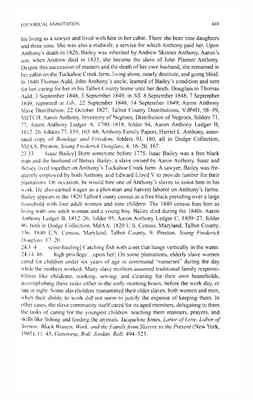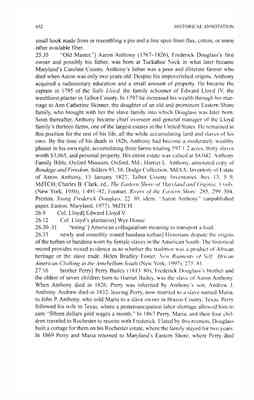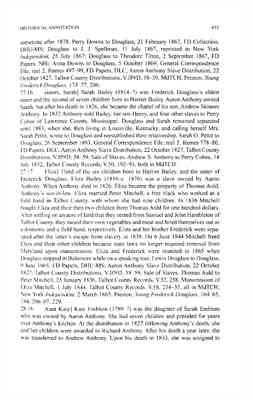Pages
21
HISTORICAL ANNOTATION 649
his living as a sawyer and lived with him in her cabin. There she bore nine daughters and three sons. She was also a midwife, a service for which Anthony paid her. Upon Anthony's death in 1826, Bailey was inherited by Andrew Skinner Anthony, Aaron's son; when Andrew died in 1833, she became the slave of John Planner Anthony. Despite this succession of masters and the death of her own husband, she remained in her cabin on the Tuckahoe Creek farm, living alone, nearly destitute, and going blind. In 1840 Thomas Auld, John Anthony's uncle, learned of Bailey's condition and sent for her, caring for her in his Talbot County home until her death. Douglass to Thomas Auld, 3 September 1848, 3 September 1849, in NS, 8 September 1848, 7 September 1849, reprinted in Lib., 22 September 1848, 14 September 1849; Aaron Anthony Slave Distribution, 22 October 1827, Talbot County Distributions, V.JP#D, 58-59, MdTCH: Aaron Anthony, Inventory of Negroes, Distribution of Negroes, folders 71, 77, Aaron Anthony Ledger A, 1790-1818, folder 94, Aaron Anthony Ledger B, 1812-26, folders 77, 159, 165-68. Anthony Family Papers, Harriet L. Anthony, annotated copy of Bondage and Freedom, folders 93, 180, all in Dodge Collection, MdAA; Preston, Young Frederick Douglass, 8, 16-20, 167. 23.33 Isaac Bailey] Born sometime before 1775, Isaac Bailey was a free black man and the husband of Betsey Bailey, a slave owned by Aaron Anthony. Isaac and Betsey lived together on Anthony's Tuckahoe Creek farm. A sawyer, Bailey was frequently employed by both Anthony and Edward Lloyd V to provide lumber for their plantations. On occasion, he would hire one of Anthony's slaves to assist him in his work. He also earned wages as a plowman and harvest laborer on Anthony's farms. Bailey appears in the 1820 Talbot County census as a free black presiding over a large household with four adult women and nine children. The 1840 census lists him as living with one adult woman and a young boy. Bailey died during the 1840s. Aaron Anthony Ledger B, 1812-26, folder 95. Aaron Anthony Ledger C, 1809-27, folder 96, both in Dodge Collection, MdAA; 1820 U.S. Census, Maryland, Talbot County, 336; 1840 U.S. Census, Maryland, Talbot County, 9; Preston, Young Frederick Douglass, 17-20. 24.3-4 seine-haulingJ Catching fish with a net that hangs vertically in the water. 24.14-16 high privilege...upon her] On some plantations, elderly slave women cared for children under six years of age in communal "nurseries" during the day while the mothers worked. Many slave mothers assumed traditional family responsibilities like childcare, cooking, sewing, and cleaning for their own households, accomplishing these tasks either in the early morning hours, before the work day, or late at night. Some slaveholders manumitted their older slaves, both women and men, when their ability to work did not seem to justify the expense of keeping them. In other cases, the slave community itself cared for its aged members, delegating to them the tasks of caring for the youngest children: teaching them manners, prayers, and skills like fishing and feeding the animals. Jacqueline Jones, Labor of Love, Labor of Sorrow: Black Women, Work, and the Family from Slavery to the Present (New York, 1985), 11-43; Genovese, Roll, Jordan, Roll, 494-523.
22
650 HISTORICAL ANNOTATION
24.17-18 practice of separating mothers from their children] While many pregnant slave women continued physical labor until mere weeks before their children were to be born, slaveholders, interested in each child as a new acquisition, often freed a mother for days or weeks to nurse a newborn. Some owners even established nursing schedules for the infants. Some mothers, like Douglass's, were hired out to other plantations and rarely saw their children. But it was more often the case that slave mothers shared cabins with their children and spent as much time caring for them as possible, given a demanding work day. During the day, young children were frequently neglected in the plantation nursery or cared for by siblings scarcely older than themselves. As a result, child mortality was high. However, many slave autobiographies attest to the love, compassion, and hope within slave families, relating stories of children fighting overseers who tried to beat their mothers, or of offspring choosing to remain in bondage with their mothers when offered an opportunity for escape or freedom. John W. Blassingame, The Slave Community: Plantation Life in the Antebellum South (1972; New York, 1979), 77-103. 24.24 grandmother's five daughters] Of the twelve children born to Betsey and Isaac Bailey, five daughters, all owned by Aaron Anthony were hired out. Milly Bailey (1790-?), the first child of Isaac and Betsey, worked on Aaron Anthony's Tuckahoe farms and had seven children. Betsey and lsaac's second child, Harriet (1792-1825), was hired out by Anthony to local farmers as a field hand from 1808 until her death. In February 1818, while serving Perry Steward, a tenant farmer on Anthony's Holme Hill Farm in Tuckahoe Creek, she gave birth to Frederick Augustus Bailey, her fourth of six or seven children. In late 1825 or early 1826, she died on the Holme Hill Farm. Jenny Bailey (1799-?), the third daughter of Betsey and Isaac, either worked on Anthony's Tuckahoe farms or was hired out to other local farmers. In 1825, after having had three children, Jenny ran away with her husband, Noah, and was never seen again. In retaliation, Anthony sold her two living children into the Lower South. The fourth daughter, Hester Bailey (1810-?), bore one child, and was last mentioned in 1827, when she was awarded to Thomas Auld after the death of Aaron Anthony. Priscilla Bailey (1816-?), the eleventh of Betsey and Isaac's twelve children, was given to Richard Lee Anthony upon the death of his father, Aaron Anthony, in 1826. Aaron Anthony Ledger B, 1812-26, folders 95, 165, Dodge Collection, MdAA; Aaron Anthony Slave Distribution, 22 October 1827. Talbot County Distributions, V.JP#D, 58- 59, MdTCH; Preston, Young Frederick Douglass 8-9, 17-18, 21, 27, 34-35, 37, 62-65, 205-06, 219, 221. 24.32 Prichard's "Natural History of Man."] James Cowles Prichard (17861848) was an English physician, notable for having held a favorable view on the origin and potential of blacks. In The Natural History of Man, he argues for monogenism, claiming that humans were originally black, their skin color becoming lighter over time. Prichard believed that racial varieties were inherent in the original structure of a being rather than imposed by external circumstances like climate. The figure to which Douglass refers is a sketch of the Egyptian Pharaoh, Ramses the Great, found
23
HISTORICAL ANNOTATION 651
in Prichard's book. James Cowles Prichard, The Natural History of Man, 3d ed. (London, 1848), 1-26, 157; George W. Stocking, Jr. , ed., Researches into the Physical History of Man (1813; Chicago, 1973), ix-ex. 24.36 Of my father I know nothing] In Narrative Douglass not only claims that his father was a white man but even intimates that he was rumored to be his first master, Aaron Anthony. However, this speculation becomes more doubtful in his subsequent autobiographies. "My father was a white man, or nearly white," Douglass adds to his original remark in My Bondage and My Freedom, while also mentioning that he cannot give any credence to the rumor that his father was Anthony. By the time he wrote Life and Times, Douglass had ceased to speculate about the actual identity of his father. Douglass Papers, ser. 1, 2:35; Preston, Young Frederick Douglass, 22-23. 24.38 By its law. . .of its mother] A 1662 Virginia statute applies the civil law concept partus sequitar ventrem, stating that "all children borne in this country shall be held bond or free only according to the condition of the mother." This law placed the offspring of black human beings in the same condition as the broods of tame and domestic animals, a departure from the English common-law rule that a child follows the status of the father. The reasoning behind this practice was that it benefited slaveholders economically and allowed them to avoid complex social situations that might undermine the emerging institution of slavery. V. Lynn Kennedy, Born Southern: Childbirth, Motherhood, and Social Networks in the Old South (Baltimore, 2010), 160-65; Paul Finkelman, "The Crime of Color," Tulane Law Review, 67:2063-112 (June 1993). 25.3-4 one drop of African blood] Douglass's reference to "one drop of African blood" predates the first legal statute (Tennessee, 1910) that explicitly stated that such a measurement should determine race. Virginia adopted its one-drop rule in the 1920s; however, during the nineteenth century, state courts classified race using definitions more complex than the one-drop rule. Some scholars write ahout this rule as though it had been adopted by all states in antebellum America through Reconstruction to the Jim Crow era and beyond. Although there is little evidence supporting this claim of widespread legislation, the one-drop rule as a social definition of race dictated, to an extant, the self-identification of blacks in the United States. F. James Davis, Who Is Black? One Nation's Definition (University Park, Pa., 1991), 15; Michael A. Elliot, "Telling the Difference: Nineteenth-Century Legal Narratives of Racial Taxonomy," Law and Social Inquiry, 24:611-36 (Summer 1999); Ariela J. Gross, "Litigating Whiteness: Trials of Racial Determination in the Nineteenth-Century South," Yale Law Journal, 108:109-88 (October 1998); Finkelman, "Crime of Color," 2063-112. 25.25 Mr. Lee's mill] Levi Lee owned a mill near Holme Hill Farm and the Tuckahoe River in 1820. In that year. he headed a large household of eight family members and six slaves. 1820 U.S. Census, Maryland, Talbot County, 48; Preston, Young Frederick Douglass, 36. 25.28-29 pin-hook and thread line] A primitive fishing tackle composed of a
24
652 HISTORICAL ANNOTATION
small hook made from or resembling a pin and a line spun from flax, cotton, or some other available fiber. 25.35 "Old Master."] Aaron Anthony (1767-1826), Frederick Douglass's first owner and possibly his father, was born at Tuckahoe Neck in what later became Maryland's Caroline County. Anthony's father was a poor and illiterate farmer who died when Aaron was only two years old. Despite his impoverished origins, Anthony acquired a rudimentary education and a small amount of property. He became the captain in 1795 of the Sally Lloyd, the family schooner of Edward Lloyd IV, the wealthiest planter in Talbot County. In 1797 he increased his wealth through his marriage to Ann Catherine Skinner, the daughter of an old and prominent Eastern Shore family, who brought with her the slave family into which Douglass was later born. Soon thereafter, Anthony became chief overseer and general manager of the Lloyd family's thirteen farms, one of the largest estates in the United States. He remained in this position for the rest of his life, all the while accumulating land and slaves of his own. By the time of his death in 1826, Anthony had become a moderately wealthy planter in his own right, accumulating three farms totaling 597 1-2 acres, thirty slaves worth $3,065, and personal property. His entire estate was valued at $8,042. Anthony Family Bible, Oxford Museum, Oxford, Md.; Harriet L. Anthony, annotated copy of Bondage and Freedom, folders 93, 58, Dodge Collection, MdAA; Inventory of Estate of Aaron Anthony, 13 January 1827, Talbot County Inventories, box 13, 5-9, MdTCH; Charles B. Clark, ed., The Eastern Shore of Maryland and Virginia, 3 vols. (New York, 1950), 1:491-92; Footner, Rivers of the Eastern Shore, 285, 299-304; Preston, Young Frederick Douglass, 22-30; idem., "Aaron Anthony" (unpublished paper, Easton, Maryland, 1977), MdTCH. 26.9 Col. Lloyd] Edward Lloyd V. 26.12 Col. Lloyd's plantation] Wye House. 26.30-31 "toting"] American colloquialism meaning to transport a load. 26.33 newly and smoothly ironed bandana turban] Historians dispute the origins of the turban or bandana worn by female slaves in the American South. The historical record provides mixed evidence as to whether the tradition was a product of African heritage or the slave trade. Helen Bradley Foster, New Raiments of Self: African American Clothing in the Antebellum South (New York, 1997), 275-81. 27 .16 brother Perry] Perry Bailey (1813-80), Frederick Douglass's brother and the oldest of seven children born to Harriet Bailey, was the slave of Aaron Anthony. When Anthony died in 1826, Perry was inherited by Anthony's son, Andrew J. Anthony. Andrew died in 1832, leaving Perry, now married to a slave named Maria, to John P. Anthony, who sold Maria to a slave owner in Brazos County, Texas. Perry followed his wife to Texas, where a postemancipation labor shortage allowed him to earn "fifteen dollars gold wages a month." In 1867 Perry, Maria, and their four children traveled to Rochester to reunite with Frederick. Elated by this reunion, Douglass built a cottage for them on his Rochester estate, where the family stayed for two years. In 1869 Perry and Maria returned to Maryland's Eastern Shore, where Perry died
25
HISTORICAL ANNOTATION 653
sometime after 1878. Perry Downs to Douglass, 21 February 1867, FD Collection, DHU-MS; Douglass to J. J. Spellman, 11 July 1867, reprinted in New York Independent, 25 July 1867; Douglass to Theodore Tilton, 2 September 1867, FD Papers, NHi; Anna Downs to Douglass, 5 October 1869, General Correspondence File, reel 2, frames 497-99, FD Papers, DLC; Aaron Anthony Slave Distribution, 22 October I827, Talbot County Distributions, V.JP#D, 58-59, MdTCH; Preston, Young Frederick Douglass, 175-77, 206. 27.16 sisters, Sarah] Sarah Bailey (1814-?) was Frederick Douglass's oldest sister and the second of seven children born to Harriet Bailey. Aaron Anthony owned Sarah, but after his death in 1826, she became the chattel of his son, Andrew Skinner Anthony. In 1832 Anthony sold Bailey, her son Henry, and four other slaves to Perry Cohee of Lawrence County, Mississippi. Douglass and Sarah remained separated until 1883, when she, then living in Louisville, Kentucky, and calling herself Mrs. Sarah Pettit, wrote to Douglass and reestablished their relationship. Sarah O. Pettit to Douglass, 26 September 1883, General Correspondence File, reel 3, frames 778- 80, FD Papers, DLC; Aaron Anthony Slave Distribution, 22 October 1827, Talbot County Distributions, V.JP#D, 58-59. Sale of Slaves, Andrew S. Anthony to Perry Cohee, 14 July 1832, Talbot County Records, V.50, 192-93, both in MdTCH. 27.17 Eliza] Third of the six children born to Harriet Bailey, and the sister of Frederick Douglass, Eliza Bailey (1816-c. 1876) was a slave owned by Aaron Anthony. When Anthony died in 1826, Eliza became the property of Thomas Auld, Anthony's son-in-law. Eliza married Peter Mitchell, a free black who worked as a field hand in Talbot County, with whom she had nine children. In 1836 Mitchell bought Eliza and their then two children from Thomas Auld for one hundred dollars. After settling on an acre of land that they rented from Samuel and John Hambleton of Talbot County, they raised their own vegetables and meat and hired themselves out as a domestic and a field hand, respectively. Eliza and her brother Frederick were separated after the latter's escape from slavery in 1838. On 6 June 1844 Mitchell freed Eliza and their other children because state laws no longer required removal from Maryland upon manumission. Eliza and Frederick were reunited in 1865 when Douglass stopped in Baltimore while on a speaking tour. Lewis Douglass to Douglass, 9 June 1865, FD Papers, DHU-MS; Aaron Anthony Slave Distribution, 22 October 1827, Talbot County Distributions, V.JP#D, 58- 59. Sale of Slaves, Thomas Auld to Peter Mitchell, 25 January 1836, Talbot County Records, V.52, 258. Manumission of Eliza Mitchell, 1 July 1844, Talbot County Records, V.58, 234-35, all in MdTCH; New York Independent, 2 March 1865; Preston, Young Frederick Douglass, 164-65. 184, 206-07, 229. 28.16 Aunt Katy] Kate Emblem (1789-?) was the daughter of Sarah Emblem who was owned by Aaron Anthony. She had seven children and presided for years over Anthony's kitchen. At the distribution in 1827 following Anthony's death, she and her children were awarded to Richard Anthony. After his death a year later, she was transferred to Andrew Anthony. Upon his death in 1833, she was assigned to




